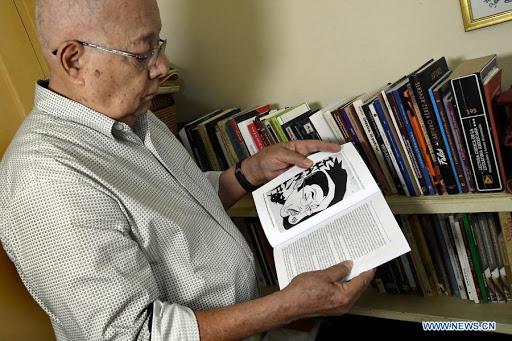More than two decades ago, the doctor in philological sciences and emeritus professor at the University of Havana, Rogelio Rodríguez Coronel , accepted the challenge of the American academic Ivan Schulman to investigate the Chinese influence on Cuban literature , which is part of the conformation of Cuban nationality.
That impulse led Rodríguez Coronel to immerse himself deeply in the Chinese footprint in Cuban literature, an area in which he develops with ease from his position as a philologist and author.
The challenge forced him to reread dozens of books by Cuban authors in a literary research to find the imprint of the Chinese, which was an invaluable experience to understand the culture of a nation that he admires.
From this monumental inquiry, the essay El rastro chino en la literature cubana was born two years ago , a text published by the Editorial Universidad de La Habana that won the 2019 Literary Critics Prize , an award that will be presented within the framework of the International Book Fair from Havana.
"It has been proven that a part of our literature has Chinese roots, something we knew empirically, but what the book aims to do is study the richness, vastness and variety of that presence," Rodríguez Coronel explained to Xinhua .
The essay investigates the work of important Cuban novelists such as Ramón Meza (1861-1911) in the 19th century and José Lezama Lima (1910-1976) in the 20th century, although they are not the only ones whose texts address the Chinese as a presence that it is integrated into the Cuban daily life.
The Cuban author also analyzes the verses of Regino Pedroso (1896-1983), Fayad Jamís (1930-1988) and Miguel Barnet (1940), as well as other Cuban poets who in their works have addressed the immense Chinese culture.
The exhaustive investigation, which opens and closes with the Chinese proverb "The strongest and lushest tree lives on what it has underneath," also reaches these years of the 21st century with the analysis of works by Cuban authors based or not on the island.
"The Chinese root in Cuban culture is one of the many to take into account," emphasized the also director of the Cuban Academy of Language and a corresponding member of the Royal Spanish Academy.
The academic, born in 1946, recalled that Cuban culture is open and has been subjected to multiple dialogues and influences.
According to Rodríguez Coronel, the Chinese arrived in Cuba with their culture more or less intact, reinforced by a second wave of more economically solvent countrymen who arrived from the United States.
For the journalist, novelist, and critic Marta Rojas , Rodríguez Coronel's book is an "essential" text, exploring the influence of Chinese in Cuban literature.
From the cover, the text is accompanied by works by Flora Fong, Pedro Eng and Alexander Hernández Chang, three Cuban painters of Chinese descent and whose paintings show the cultural mix of both countries.
The essayist has not stopped at the successes of the singular work, but continues his studies to prepare a second expanded edition in which the Chinese mark on Cuban culture will surely become more evident.


Deje un comentario